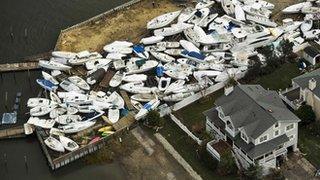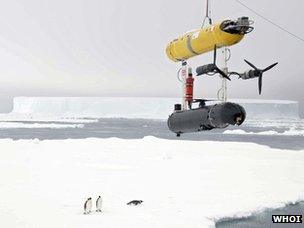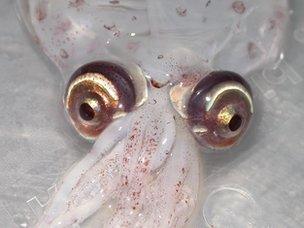Robots ride the ocean blue
- Published

The destructive power of superstorm Sandy did not put off one wave-riding robot
When superstorm Sandy was rampaging across the Caribbean and mid-Atlantic, heralded by gale force winds, torrential rain and surging tides, people rushed to get out of its way.
Tens of thousands swapped homes on the coast for temporary shelters where they could huddle while Sandy rolled through.
Given that Sandy caused more than 200 deaths, they were perhaps prudent to steer clear.
But some welcomed its approach, eager to get in the way, and shrugged off everything the giant storm could throw. This some was not a someone but a something - a wave-gliding robot called Mercury.
As Sandy thundered past, this brave robot sat in the ocean about 100 miles (160km) off the coast of New Jersey, transmitting data in real time about the extreme weather at the storm's heart.
The robot combines an upper float the size of a surfboard with a lower instrument-packed pod and is one of many types of autonomous underwater vehicles (AUVs) oceanographers are using in increasing numbers.
"People are expensive," says Brian Claus from the autonomous oceans systems lab at Newfoundland's Memorial University. "AUV's maximise your time in the field."
Better built
Instead of burning fuel to get a ship full of people out to a study site and then chug up and down to gather data, robots can be launched that survey by themselves.
Some modern AUVs can be launched from the shore, find their own way to a study site, carry out experiments and then return when their job is completed.

Robot subs are being used to carry out surveys under polar ice
AUV prices have dropped to such an extent that projects are now being contemplated that involve hundreds of robot craft piloting the seas, gathering data about currents, temperature, salinity, acidity and a host of other key environmental markers.
What has also improved radically is their reliability, says Hanumant Singh, a scientist in the applied ocean physics and engineering department at Woods Hole Oceanographic Institution.
An AUV, he adds, is a composite of six separate systems. When the first AUV's were built, each one of these systems, which include power, sensors and propulsion - was about 95% reliable.
"You would think that's pretty reasonable, but when you put all six together the probability of them all working diminishes considerably," Mr Singh says.
Time and testing means those individual systems are now more than 99% reliable, making the whole robotic craft about 95% reliable.
That improved reliability and low cost makes them perfect for some jobs but does not mean oceanographers are abandoning tried and tested tools such as remotely operated vehicles (ROVs) or manned submersibles.
AUVs are finding a role in the places too dangerous, such as under polar ice caps, for people or very expensive ROVs to venture, Mr Singh says.
And this means humans are freed from the dull work involved in ocean surveying missions.
"It's really boring for a human operator to sit in the middle of the water column, not at the top or the bottom and just move in a straight line," Mr Singh says.
But despite the rapid improvements, robotic craft have yet to match the flexibility of ROVs.
That will change as more firms produce AUVs, according to Mr Singh. Only a handful of firms currently make AUVs, while more than 150 produce ROVs, he says.
Soft shell
Scientists and engineers are working hard to make AUVs that can fulfil any role oceanographers need.
Many of the craft available now work close to the surface, but a lot of research is going into producing vehicles that can work up to 6km (3.7 miles) down - a depth that covers 97% of the world's oceans.

A soft body helps this squid survive in the deep sea
One group of researchers at the UK's National Oceanographic Centre in Southampton has taken the cue for their deep-sea AUV from nature.
Dr Alexander Phillips and his colleagues are adapting the bodily characteristics of the Atlantic cranch squid, Teuthowenia megalops, for their AUV.
The squid has a flexible, fluid filled body that copes much better with deep-water pressure than do the rigid hulls of current AUVs.
Copying that, says Dr Phillips, could solve some of the engineering problems that crop up as AUVs dive deeper.
The researchers have tested 44 different fluids to see which is the most suitable to fill the floppy-body of the robot.
Shark oil looked like a good candidate, Dr Phillips says, but proved too expensive.
The team settled on mineral oil and will soon be testing it in the UK's national oceanography pressure pot, which can simulate conditions at different depths.
If the design is successful, it might mean the price of an AUV drops to less than £10,000 and it will be able to take on long-term research in the deep ocean.
Even without these innovations, AUVs are already proving a boon to oceanographers, says Mr Singh.
For instance, for years oceanographers have used drilled cores to estimate the thickness of ice in the Antarctic.
However, research carried out with AUVs is leading many to re-think the accuracy of those cores.
The 3D models of ice being produced are almost unique and, as with the robot that withstood Sandy, justify the risk of sending in a pricey robot that might not return.
"The number of deployments should equal the number of recoveries," Mr Singh says.
"It's tough if that's not the case every now and then, but it's OK if you get data you cannot get any other way."
- Published5 December 2012
- Published23 February 2012
- Published1 August 2012